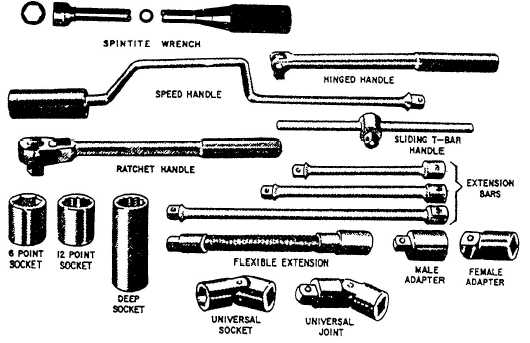SOCKET WRENCH
The socket wrench is one of the most versatile
wrenches in the toolbox. It consists of a handle and a
socket wrench that can be attached to the handle.
The Spintite wrench shown in figure 2-5, is a
special type of socket wrench. It has a hollow shaft to
accommodate a bolt protruding through a nut, has a
hexagonal head, and is used like a screwdriver. It is
supplied in small sizes only and is useful for assembly
and electrical work. When used for the latter
purpose, it must have an insulated handle.
A complete socket wrench set consists of several
types of handles, bar extensions, adapters, and a vari-
ety of sockets (fig. 2-5).
Sockets
A socket (fig. 2-6) has a square opening cut in
one end to fit a square drive lug on a detachable
handle. In the other end of the socket is a 6-point or
12-point opening very much like the opening in the
box end wrench. The 12-point socket needs to be
swung only half as far as the 6-point socket before it
has to be lifted and fitted on the nut for a new grip. It
can therefore be used in closer quarters where there
is less room to move the handle. (A ratchet handle
eliminates the necessity of lifting the socket and
refitting it on the nut every time a turn is made.)
Sockets are classified for size according to two
factors. One is the size of the square opening, which
fits on the square drive lug of the handle. This size is
known as the drive size. The other is the size of the
opening in the opposite end, which fits the nut or
bolt. The standard toolbox can be outfitted with
sockets having 1/4-, 3/8-, and 1/2-inch square drive
lugs. Larger sets are usually available in the toolroom
for temporary checkout. The openings that fit onto
the bolt or nut are usually graduated in 1/16-inch
sizes. Sockets are also made in deep lengths to fit
over spark plugs and long bolt ends.
Figure 2-6.—12-point socket.
Figure 2-5.—Socket set components.
2-4





